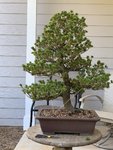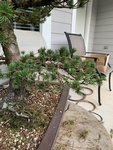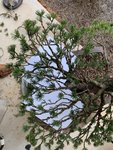This post is for @coh. I actually used some guy wires! (For those wondering what this is all about, I guess it was about a year ago Coh posted a tree styled using a lot guy wires, and no traditional wiring. I had enough vintage Bordeaux red wine in me to go on a rant about wiring... Anyway, Coh likes to tease me about using guy wires.)
This is a Zuisho JWP I bought from Julian Adams last December at the Silhouette Show in Kannapolis, NC. If you have the opportunity to go this year, you should. We don't have many "Winter" shows, and I think that's when many bonsai look their best.
I have not really spent a lot of time with this tree. It did get repotted out of the turface that Julian uses into ClayKing with added pumice in March. It was half bare rooted, and I did substantial work to improve the root system. One branch was pruned. And it was lightly cut back in anticipation of Spring growth.
I used the tree as a wiring demo tree at the Atlanta Bonsai Society Show a couple weeks later. Since it was freshly potted, I didn't do any heavy bending. Mainly I was demonstrating how to spiral wire on. I only was able to get the three bottom branches "mostly wired".
So, this morning, I spent some time figuring out what it needed.
This tree was created by Julian as an air layer. It was a branch on another tree. That was 20 years ago when he layered it.

Ok, so you how you style a branch on a pine tree? You alternate branches left, right, left, right... And no branches going straight down? Well, that's what this tree was. (Is.). There are strong branches on either side of the trunk (former branch main line), some on the back (former top of the main line branch), and none in the front of the tree until we get up close to the apex since the front of the tree was the bottom of the branch when it was still a branch.
Thus, it presents a rather "flat" view. I spun it around lots of time trying to determine if the was a better front, and really couldn't find one. But the two lowest branches are growing straight out sideways. And, well, it would be better if they came forward a bit. They're pretty thick (too thick, really, but without grafting on new ones and completely starting over, we're stuck with them) and it would take really heavy wire to move them, and even then, I'm not sure.
So, guy wire!
I ran a piece of 10 gauge copper under the bottom of the front of the pot, coming up thru the corner drain holes in front. Using my Jin pliers, I made a loop in the wire right at the soil level or just below. On both sides.
Then, I experimented wire various wire locations to see where I would be able to get the effect I was after: I wanted the branches to come down a little, but mainly I wanted them to come forward. I found that using the loop that was under the branch mainly just pulled it down. But if instead I used the loop on the far side of the pot, I was able to pull the branch toward the front a lot, and only a little bit down.
There explains the crisscross.

I used stainless steel guy wires. Stainless steel is stronger than copper. As it turns out, copper would have worked just as well. There not a lot of pressure. In this case, copper would have been easier to use. Steel is rather stiff and harder to grip and twist with the pliers. I haven't worked that much with steel, so it was a learning experience!
It's getting close to time to wire JWP. When the old needles turn yellow to brown and fall off easily, JWP is ready to wire. Late August to September is usually good for us here in North Georgia. And that's the time to start fertilizing JWP. To build strength for next spring
Coh, I'm looking forward to meeting you in a little over a month!
This is a Zuisho JWP I bought from Julian Adams last December at the Silhouette Show in Kannapolis, NC. If you have the opportunity to go this year, you should. We don't have many "Winter" shows, and I think that's when many bonsai look their best.
I have not really spent a lot of time with this tree. It did get repotted out of the turface that Julian uses into ClayKing with added pumice in March. It was half bare rooted, and I did substantial work to improve the root system. One branch was pruned. And it was lightly cut back in anticipation of Spring growth.
I used the tree as a wiring demo tree at the Atlanta Bonsai Society Show a couple weeks later. Since it was freshly potted, I didn't do any heavy bending. Mainly I was demonstrating how to spiral wire on. I only was able to get the three bottom branches "mostly wired".
So, this morning, I spent some time figuring out what it needed.
This tree was created by Julian as an air layer. It was a branch on another tree. That was 20 years ago when he layered it.

Ok, so you how you style a branch on a pine tree? You alternate branches left, right, left, right... And no branches going straight down? Well, that's what this tree was. (Is.). There are strong branches on either side of the trunk (former branch main line), some on the back (former top of the main line branch), and none in the front of the tree until we get up close to the apex since the front of the tree was the bottom of the branch when it was still a branch.
Thus, it presents a rather "flat" view. I spun it around lots of time trying to determine if the was a better front, and really couldn't find one. But the two lowest branches are growing straight out sideways. And, well, it would be better if they came forward a bit. They're pretty thick (too thick, really, but without grafting on new ones and completely starting over, we're stuck with them) and it would take really heavy wire to move them, and even then, I'm not sure.
So, guy wire!
I ran a piece of 10 gauge copper under the bottom of the front of the pot, coming up thru the corner drain holes in front. Using my Jin pliers, I made a loop in the wire right at the soil level or just below. On both sides.
Then, I experimented wire various wire locations to see where I would be able to get the effect I was after: I wanted the branches to come down a little, but mainly I wanted them to come forward. I found that using the loop that was under the branch mainly just pulled it down. But if instead I used the loop on the far side of the pot, I was able to pull the branch toward the front a lot, and only a little bit down.
There explains the crisscross.

I used stainless steel guy wires. Stainless steel is stronger than copper. As it turns out, copper would have worked just as well. There not a lot of pressure. In this case, copper would have been easier to use. Steel is rather stiff and harder to grip and twist with the pliers. I haven't worked that much with steel, so it was a learning experience!
It's getting close to time to wire JWP. When the old needles turn yellow to brown and fall off easily, JWP is ready to wire. Late August to September is usually good for us here in North Georgia. And that's the time to start fertilizing JWP. To build strength for next spring
Coh, I'm looking forward to meeting you in a little over a month!







